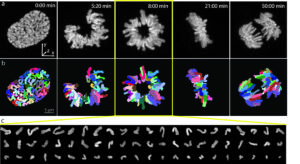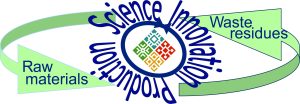
An all-Bulgarian research team from the “Acad. Roumen Tsanev” Institute of Molecular Biology at BAS published an article in the Nature Cell Biology journal on 14 April 2025. The authors of the study are Rumen Stamatov, Sonya Uzunova, Yoana Kicheva, Maria Karaboeva and Tavian Blagoev, under the supervision of Assoc. Prof. Stoyno Stoynov. The team overcomes long-standing methodological challenges in the study of chromosome dynamics during mitosis, a key process in cell division.
Over the course of more than four years, scientists developed an innovative method called FAST CHIMP (Facilitated Segmentation and Tracking of Chromosomes in Mitosis Pipeline). Thanks to it, they were able to track the movement of all human chromosomes at 8-s resolution – from the initial phase of mitosis (prophase) to its final phase (telophase) – something that was previously not possible with available technologies.
The chromosomes containing the compacted DNA are arranged in the division spindle during mitosis, and their correct organisation is vital for the correct separation of genetic information. Errors in this process can lead to chromosomal translocations – changes that underlie a number of cancers.
By combining super-resolution microscopy and deep machine learning, the FAST CHIMP method provides unprecedented accuracy and the ability to monitor the movement and spatial arrangement of chromosomes in real time. Among the team’s key findings are new patterns in centrosome dynamics and their impact on chromosome architecture.
The research is another major step forward in unraveling the three-dimensional organization of the genome in living cells – an achievement with enormous potential for molecular biology, genetics and medicine.
The FAST CHIMP method will help to better understand why cells divide incorrectly – a process that can lead to serious genetic errors and cancer. This discovery opens the way to more accurate diagnoses and new, more effective therapies. In the future, the method could be incorporated into automated cell analysis systems and high-tech diagnostic platforms.
The original article can be viewed here:
https://www.nature.com/articles/s41556-025-01637-6



